History of the Appearance and Spread of the Onion
The emergence of the onion occurred about 4,000 years ago in Asia. Afghanistan and Iran are now in this area. Onions were grown as a vegetable crop in ancient Egypt, Greece and India. Mentions of onions were found in the ancient papyri. And its image is on the walls of the ancient Egyptian pyramids.
In ancient times, people believed that onions had medicinal and magical properties. In ancient Rome, it was believed that if a meal contained a lot of onions, it meant it gave energy, courage, and strength. The ancient Greeks considered the onion a symbol of the structure of the universe.
Ancient scientists used the cut onion as a visual aid for the study of astronomy. Its overlapping scales resembled the celestial spheres that carried the celestial bodies and were attached to the center of the universe. The onion was considered a sacred plant. Large, beautiful bulbs were offered as gifts to the gods by the Ancient Greeks. And the Ancient Egyptians – made oaths on an onion to prove their point.
In Europe the bow appeared at the turn of X – XI centuries. In X – XII centuries onions became a major part of the food of the common people in Portugal, Spain and France.
In Russia, onions became known in the XII-XIII centuries. Since then they have been used in almost every dish.
In the late Middle Ages came the science of cooking and the first cookbooks. Onions were a component of many exquisite
dishes. Onion production reached an industrial scale in almost all countries of Western and Eastern Europe.
Onion culture centers emerged. Their geographical names gave names to the first varieties. Onion culture was particularly developed in Spain. The famous semispicy varieties of Spanish onions were created there. Even today it surpasses all known varieties of onion in terms of bulb size and yield.
Useful Properties of Onions
Onions contain many useful substances. Among them are folic acid, vitamin C, calcium, quercetin, potassium and calcium. Thanks to these elements – it supports the immune system. It is also able to reduce allergic reactions to the external environment – useful for allergic people. People with asthma, can eat it in addition to the treatment.

Onions have antifungal and antiviral properties. When the onion is cut, allicin begins to be released. Because of this substance, the vegetable has a characteristic smell. Allicin helps the body fight infections.
Scientists recognize onions as a cancer preventative. When you eat it, the body begins to produce tripeptide and glutarione. They act as antioxidants. They cleanse the body of toxins and carcinogens and slow down the development of metastases.
Onions also have antibacterial properties, as they have phytoncides. He is able to fight many germs, the causative agents of dysentery, diphtheria and tuberculosis, streptococci.
The benefits of onions are very broad. Since it contains potassium – it is useful for people with heart and vascular problems. This vegetable helps to stimulate the digestive process. It gets rid of constipation and purifies the blood. Onions have a stimulating effect. Therefore, it will help hypertensive people, to increase potency and with feelings of weakness.
Onions are beneficial for sleep disorders. If you use it in moderation, it will have the effect of a sleeping pill. Onions are actively used in pharmacology for the manufacture of medicines and dietary supplements, in cosmetology, in folk medicine. It is used for masks that treat weakened and dry hair. From this tool, the hair begins to grow faster.
But not everyone can use onions. It can cause irritation of the digestive organs, increase acidity.With excessive use can affect the nervous system. Excitement occurs – this has a bad effect on the heart. It is also possible to increase blood pressure or an asthma attack.
The useful properties of onions are fully manifested when eating raw onions. With any heat treatment the amount of useful substances is reduced.
Calories and Nutritional Value of Onions
In 100 grams of raw onions 36-40 kcal, protein – 1.1 g, fat – 0.1 g, carbohydrates – 7.64 g.
Varieties and Types of Onions
There are many varieties of onions. They differ in size and shape of the bulbs, their color, as well as their taste properties. It is believed that the darker the onions, the sweeter they are.
All varieties fall into three major categories:
White onions
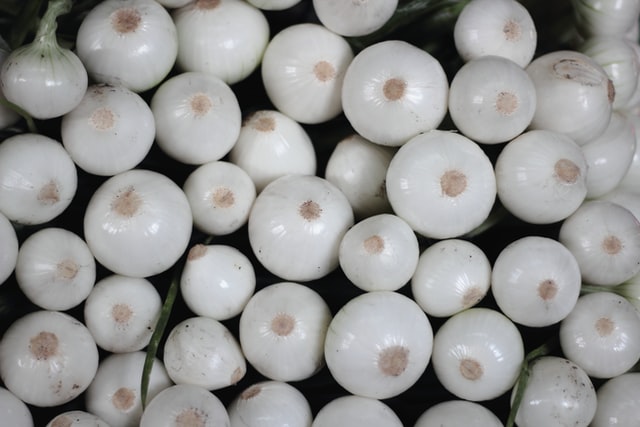
Onions that can be cooked quickly, have a mild flavor and do not sting to the eyes when cut. These onions have light husks and a more delicate flavor. Most often used in salads.
Yellow (golden, regular) onions
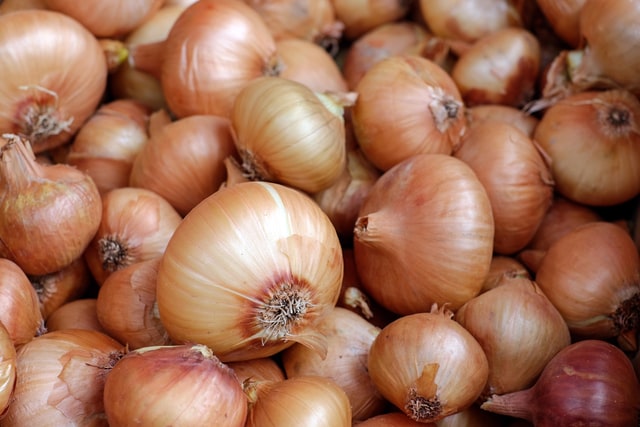
Most commonly used in cooking. It is bitter, and stings your eyes when cut raw. Has yellow scales
Red onion (blue)
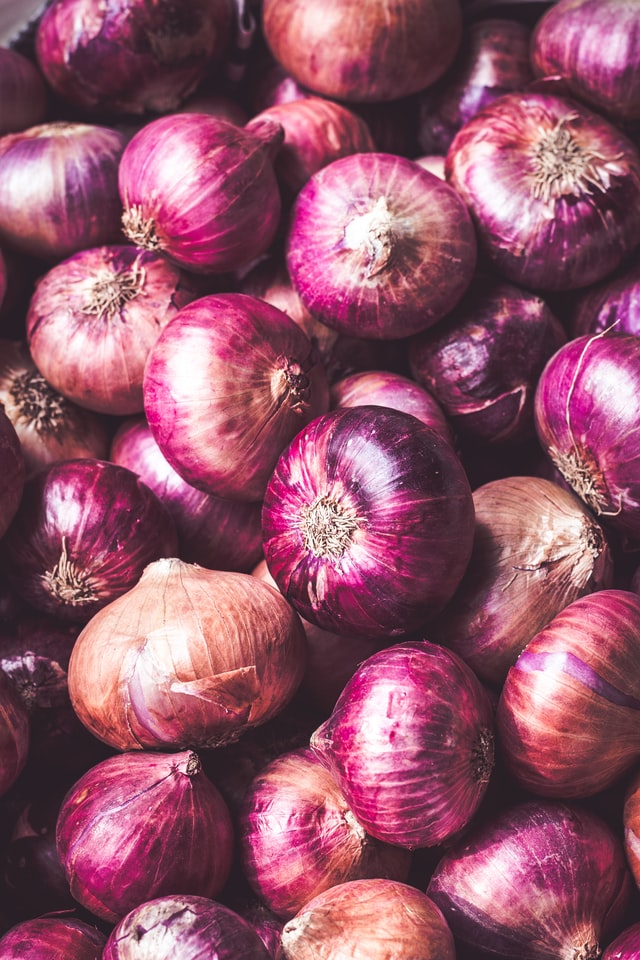
Blue onions are also called red onions. They are less bitter, have a more delicate flavor, and are good as salad dressings.
In terms of shape, onions can be:
- large (round or oval);
- medium-sized (different shapes);
- small (plum-shaped).
Green onion is the culinary name for a number of individual species of the genus Onions. They have an above-ground (herbaceous) rather than an underground (bulb) part to eat.
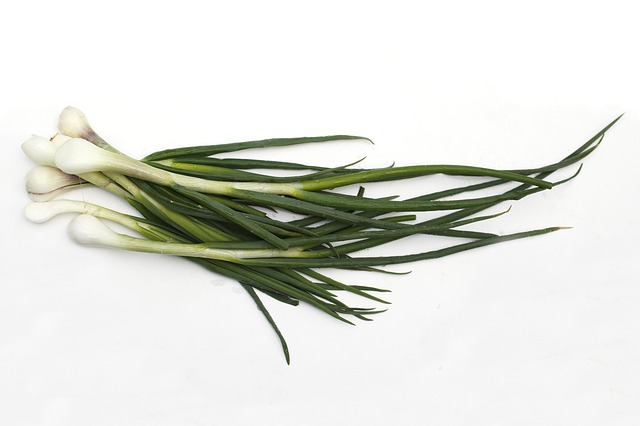
- Shallots – have elongated white or pink colored bulbs. Mild flavor and extraordinary aroma, almost no tears when sliced, contains more sugar, less water.
- Leeks – the leaves have a greenish-blue color, an interesting aroma and a pleasantly sweet taste. This onion – has no bulb. The plant ends with a thick stem. Mostly use the white part of the plant, but the green part of the leek is also useful and tasty.
- Onion-bathun – it is also called a tartar onion or dudgeon onion. The bulbs are oblong, sometimes weakly pronounced with a large leaf mass. It branches strongly, forms many leaves of dark green color, spicy taste.
- Tiered onion – called its horned onion, Egyptian onion, viviparous onion, pacing onion, Canadian onion. It got its name because of its appearance. On the arrows, flower stalks arranged in tiers of small overground bulbs (bulbs). Usually such tiers of 2-3. Aboveground bulbs brown, yellow or purple. All parts of the horny onion are suitable for eating. Bulbs are used for marinades and pickles. The flavor of the greens is spicier than that of the onions – they are added to salads.
- Skoroda onions – or chives. Fresh as a spice is added to all salads, meat, fish and vegetable dishes. Tender leaves, pleasant to the taste, without bitterness and burning, suitable for baking, omelets, sauces, gravy. The bulbs and leaves of chives taste similar to onions, but have a more delicate consistency and flavor.
If you buy onions for long-term storage, choose large heads. All varieties are suitable for cooking. Special varieties of onions are designed for planting.
How to Choose Onions?
The basic rules for choosing onions:
- The onion must be heavy enough (if the weight of the onion does not match its size – inside it may be dry or infested with parasites);
- there must not be any spots, dots or traces of insects on the skin and surface of the bulb (there must not be any mechanical damage or cracks on the bulb as well);
- the surface of the onion must be dry and sufficiently hard;
- the lighter the onions, the hotter they taste;
- red onions store less than white and golden onions (this nuance must be taken into account if you buy onions for long storage);
- onions should have a weak and not acrid flavor (the aroma should be onion and not contain any extraneous odors);
- the husk of onions of any variety should be shiny (lack of shine indicates low quality onions, their excessively long storage or improper transportation conditions);
- onions should not have any moist spots (if such spots have a pungent smell, the onion is definitely spoiled);
- the optimal size of a good onion can be between 3-5 cm (other variants may have compromised flavor characteristics);
- The spines of a good onion should not have any plaque, signs of mold, or too much soil accumulation in the area of the spines.
How Do I Know if an Onion is Spoiled?
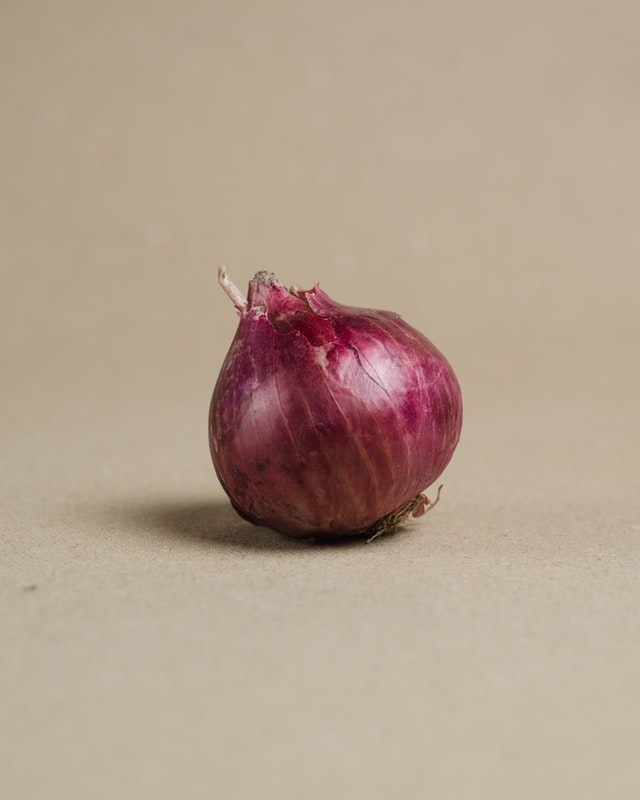
- If an onion is soft to the touch, it could be a sign of too much husk or a spoiled onion;
- Do not buy onions if the weight of the bulb does not match its size;
- Do not buy onions with sprouts (the sprouts take the juice from the bulb, so the consistency of the onion can be disturbed);
- Sprouts of onions may be a sign of improper storage;
- do not buy onions if the head is too big and has moist spots, white roots and green shoots (such onions have already started to sprout, so there will be little juiciness, and moist spots indicate a rapid rotting process);
- if an onion has a pungent or overpowering smell, it is damaged or spoiled;
- don’t buy onions if the heads are too big or too small (chemical components are likely to have been used);
- Mildew or a coating on the roots of the onion points to spoilage (eating these onions can be dangerous to your health).
Slicing Onions
Onions can be sliced in slices, cubes, rings, and half rings.
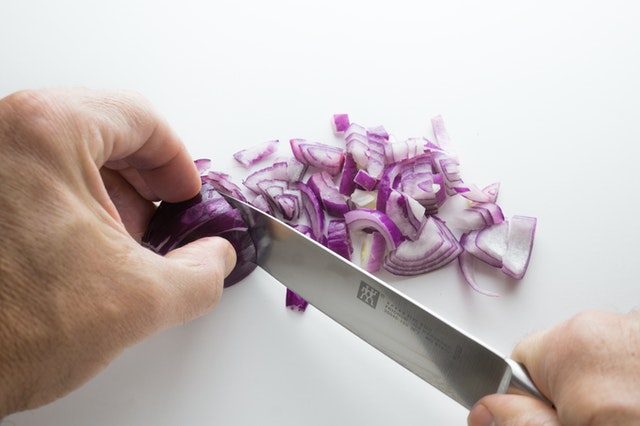
Cubes
Peel the onion and wash well. Leave the tail – it is convenient to hold by it when slicing.
Small cubes
- Place half of an onion flat on a board.
- Make several incisions parallel to the board with 2-3 mm distance from each other.
- Cut perpendicularly at the same distance.
- Hold the knife perpendicular to the surface of the board and cut small cubes with sides of 2-3 mm.
Large cubes
The cutting technique is the same as for small cubes. Only you increase the distance to 1 cm.
Straw
For this method of slicing onions, the tail must be removed. To cut the onion nicely – remove its core.
- Put half of the onion with the flat side down on a board.
- Slice the onion lengthwise to make a coarse straw.
- For fine straws, slice the half again in half lengthwise. And already this quarter cut from the top across.
- Cut at a distance of 2-3 mm.
Rings
- Cut off a little tail and root part.
- Make a small incision in the center of the circumference of the onion.
- Remove the husks with a knife and the first undried layer of onion.
- Lay the onion sideways .
- Gently slice into rings of desired thickness with a sharp knife.

Half rings
- Place half of the onion flat side down on a board.
- Make transverse cuts 2-3 mm apart.
How to Store Onions
The shelf life of onions depends on the variety. Late varieties store longest. Yellow varieties of onions are usually stored longer (among them there are more late varieties) than red and white (they are often early and medium-ripening).
To keep onions for a long time – it is necessary to properly prepare them for storage.
Preparation of onions for storage
- For long-term storage, select only dry, whole vegetables.
- It is necessary to dry the onions well in a natural way.
- It is better to dry onions outdoors under the sun. In these conditions, the onions will dry evenly and disinfect.
- Before drying, you can remove the top layer of husk. During the drying process, the onions will form a new top layer that helps them store.
- The total drying time is 7-14 days.
Storing onions at room temperature

1. In crates and baskets. Spread a small layer of well-dried onions so they don’t get soggy and rotten.
2. On the floor on a newspaper. If there aren’t many onions, you can scatter them on newspaper and store them on the floor.
3. In braids. This is the surest way to store onions. Here it is important to choose the right time to harvest the onions – so that the tops do not dry out. Otherwise, it will crumble and you will not be able to braid it. But there is no hurry either – unripe onions will not be stored. The foliage should be yellow, wilting, but not completely dried out. Dry the harvested onions for a couple of hours in the sun. Then weave them into braids and hang them indoors. Twine, narrow braid or straw can be twisted into the hairlooms to keep them strong all winter.
For this storage method, it is important to find a cool, dry place isolated from light. This will help the bulbs stay fresh longer. The shelf life of onions at room temperature is about 7-9 months.
Storing onions in the refrigerator
Onions in the refrigerator stay fresh longer and retain their properties.
If the onions are stacked in bags – there is no need to tie them. This ensures air circulation and protect the bulbs from moisture and mold development.
Store onions in the refrigerator at 0°C (32°F) to +7°C (44.6°F) for 2 to 7 months. Inspect periodically during storage and discard spoiled onions.
Onions sliced in the refrigerator have a shelf life of one month. The shelf life of green onions in the refrigerator is about 10-14 days.
Storing onions in the freezer
This storage method allows onions to stay fresh for a long time and preserves their usefulness.
The optimum temperature for storing onions in the freezer is -18°C (-0.4°F) or lower. In these conditions, they can be stored for six months. If the temperature is above -18°C(-0.4°F), the freezer shelf life of onions will be 3 months.
Before freezing, peel the onions, rinse them thoroughly, and finely chop them. Onions can be packaged in airtight containers or bags. The onions do not need to be re-frozen. It will lose all of its useful and flavorful properties.
Storage rules for peeled, sliced, fried and pickled onions:
- Put peeled whole onions in an airtight container and store at 4ºC (39.2°F) for no more than 10-14 days.
- You can wrap the sliced onions in clingfilm, put them in the refrigerator, or freeze them.
- Cooked onions (fried, boiled, baked) will keep in an airtight container for 3-5 days.
- Pickled onions will remain good for about 6 months.
Frozen onions
Slice raw onions for freezing in any way you like. Raw frozen onions are best used when cooking hot dishes. After exposure to low temperatures, they lose their color and become slightly watery.
Frozen raw onions, have a very strong flavor. Therefore, keep freezer bags away from foods that can absorb extraneous odors.
A great way to freeze onions is to fry them pre-chopped in vegetable oil. Unpack them into portioned bags and put them in the freezer.
Shelf life of onions in the freezer from 2 to 6 months. This depends on the temperature you set in your freezer. But, you should not store onions for more than six months, as they lose their flavor and aroma over time. Green onions lend themselves very well to freezing. He retains all its flavor properties. Rinse onions under water before freezing. Dry well on paper towels. It will be better if you put a bunch of onions in a jar and give them time to air-dry on their own.
There are several ways to freeze green onions: you can freeze plain slices in bulk, you can freeze them in butter in ice molds, and you can freeze them in ice molds with pure water.
Methods for Freezing Onions
Freezing raw whole onions:
- Place peeled heads in tight plastic bags.
- Let the air out, covering each vegetable.
- Tie tightly.
- Send to the freezer.
Try to spread in small portions. Otherwise, the bulbs will freeze together, you will have to break off. Instead of bags, it is allowed to wrap each onion individually in food film. To avoid spreading odor in the freezer, make at least three layers.
To keep the frozen onions from sticking together, place them in the freezer in bulk. After 5-7 hours, quickly transfer the frozen clumps to a bag.
Freezing whole blanched onions
You don’t have to stockpile raw onions. Sometimes the heads are blanched to preserve flavor, aroma, and consistency. A brief heat treatment of the frozen vegetable is only beneficial.
- Put peeled heads into boiling water. Small specimens boil for 2-3 minutes. Large onions boil for about 5 minutes.
- Take out and dip with a slotted spoon into cold water.
- After 10 minutes, place on a towel to dry.
- Freeze. Pack as in the previous option.
Freezing Roasted Onions
Dressing for soup, an ingredient in a salad, casserole, stuffing, any other dish. It’s all about fried onions. They keep well in frozen form. For frying, choose any oil to your liking. A mixture of vegetable and butter or melted butter is ideal.
- Peeled heads of onions cut into straws, cubes, use half rings, circles. Whichever you prefer.
- Pour oil into the largest frying pan and heat it up. It will perfectly replace a wok, cauldron.
- Place onions. If there is a lot of onions, fry them in batches.
- Stirring regularly, bring to a golden color. Don’t allow any scorch marks.
- Turn off the stove, and let cool.
- Unpack in small bags. On average, two tablespoons of the mixture should be enough for one serving. Be sure to stir to evenly distribute the dripping oil along with the juice.
- Seal and freeze.
Freeze chopped onions
A simple method is to chop, bagged. You can make a convenient half-finished product. The chunks are crumbly, they don’t stick together, any time you pick up the amount you need.
- Slice peeled onions into straws, cubes, half rings.
- Spread in a thin layer on a board covered with clingfilm.
- Put in the freezer for 3 hours.
- Take out, quickly gather into a tight plastic bag with your hands, squeeze if necessary.
- Seal, return to freezer.
It’s convenient to store frozen scattered onions in containers. The important condition is to have a tight lid. For long-term storage – additionally place in a bag.
Freezing dried onions
Dried onions have an incredible flavor. If suddenly he did not have time to reach full readiness, a little damp, the best solution – to freeze. A plastic, glass jar with a screw-on lid is handy for this kind of preservation.
- Pour the dried onions into the jar. Just don’t tamp it down.
- Close with a tight lid.
- Set aside to freeze.
Onions can be specially pre-dried in the oven, so they do not stick together.
Freezing Pickled Onions
There are different ways to marinate sliced onions. Sometimes the sliced product is simply sprinkled with salt, a splash of lemon juice, vinegar. Also cooked in a liquid marinade with water. Either option can be frozen.
- Distribute the vegetable in small bowls.
- Fill with liquid, juices, and crush.
- Cover, place in the freezer.
Defrosting Onions
Frozen stock is used for most dishes. It is added during the cooking process immediately to the pan. Whole heads are allowed to thaw a little, then sliced. In rare cases, complete thawing is required to remove liquid later.
- Place the onions in the refrigerator.
- Leave for a day.
- Drain off excess water, juice. You can further squeeze the casserole before adding it to the stuffing.
Defrosting in the microwave on a special mode is also used.
Cooking Methods for Onions
Onions are one of the most common vegetables. They are used raw, but also can be fried, boiled, stewed, baked, pickled, used as a filling for pies and pancakes, added to the dough. Onions are added to salads, various appetizers, soups, stews, main courses of vegetables, meat, poultry and fish, side dishes, it is combined with mushrooms and by-products, is a savory addition and an integral part of many dishes. Onions are used to make jellies and marmalades.
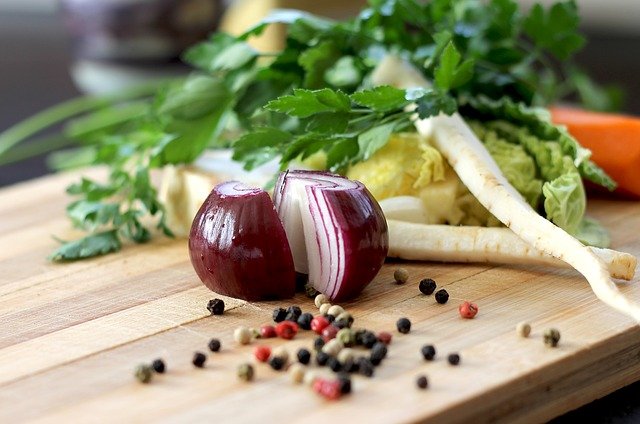
Seven ways to get the most flavor and aroma out of onions.
Caramelized Onions
- Heat 1 tablespoon olive oil and 1 tablespoon butter in a skillet over high heat.
- Add 1/2 teaspoon salt and 3/4 teaspoon brown sugar.
- Place sliced onions and fry for about 5 minutes, stirring frequently.
- Reduce heat to low and continue cooking, stirring frequently, for about 50 minutes until soft and nicely caramelized.
Suitable for: frittata, risotto, onion pie.
Sauté
- Heat a skillet over high heat.
- Add 1 teaspoon olive oil.
- Place chopped onions and fry, stirring frequently.
- Cook for about 7 minutes until soft and evenly darkened.
Suitable for: burgers, pizza, pasta sauces.
Baked onions.
- Put chopped onions in a bowl.
- Mix with 1 teaspoon olive oil and 1 teaspoon fine brown sugar.
- Place the onions on a baking tray and bake in the oven at 220 degrees for about 14-15 minutes.
Goes well with: sausages, mashed potatoes, steaks and oven-baked dishes.
Braised onions
- Pour a few teaspoons of olive oil into a frying pan so that the oil coats the bottom.
- Add sliced onions and cook on low heat for 3 minutes.
- Cover for 5 minutes and continue to cook, stirring occasionally and not letting the onions brown.
- Remove the lid and stew until onions are translucent and soft, but not brown.
Goes well with: rice, toast with cheese, white sauces.
Cooked onions
- Cut off the tails of the onions and remove the husks.
- Put onions in a saucepan with water and bring to a boil.
- Turn down the heat and simmer for about 20 minutes.
- Drain the water, put the pot on low heat and continue to cook the onions for a few more minutes until soft.
Suitable for: beef bourguignon, soups, rooster in wine.
On the grill
- Peel and slice onions into 4 pieces.
- Thread the pieces onto skewers and brush all sides with olive oil.
- Grill in the indirect zone, turning every 5 minutes.
- Cook until soft, crispy and lightly browned.
Suitable for: burgers, charcuterie, hot dogs
Roast whole onions in the oven.
- Cut off the tail from each onion.
- Place the onions on a baking tray and drizzle with 1/4 cup olive oil and 2 teaspoons melted butter.
- Bake for 25 minutes at 190 degrees until soft.
- Increase temperature to 200 degrees and bake another 15-20 minutes until lightly browned on top.
Suitable for: sandwiches, meat dishes, tacos
Cooking Recipes Ideas from Onions
Onions are added to salads, various appetizers, soups, stews, second courses of vegetables, meat, poultry and fish, side dishes. It is combined with mushrooms and by-products, is a savory addition and an integral part of many dishes. Onions are even used to make jellies and marmalade.

Simple, quick, and minimal ingredients. Great for salads, burgers, sandwiches, or as a snack. Spices up your dishes.
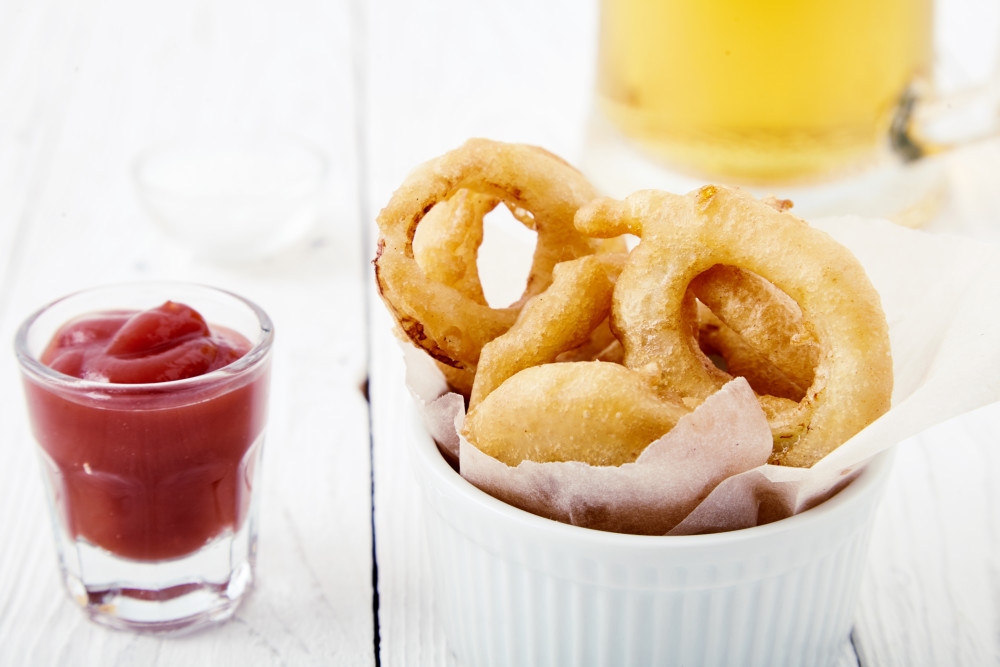
Sweet, crispy, airy light rings, with a slight scent of paprika will not leave you indifferent. You have to try this dish once and you will fall in love with it. You can add chili pepper, rosemary, thyme, oregano.
3. Classic cheeseburger with caramelized onions
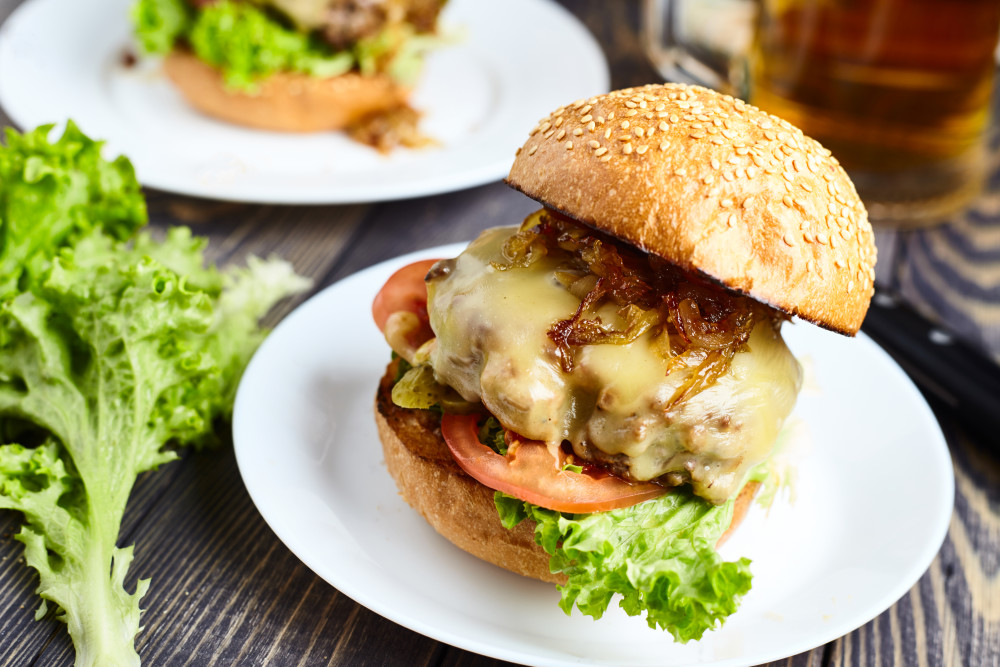
Insanely delicious combination of caramelized onions with meat patty, cheese and vegetables in a cheeseburger filling. There is no distinctive onion flavor at all. And the sweetness of these onions enhances the taste of the other ingredients.
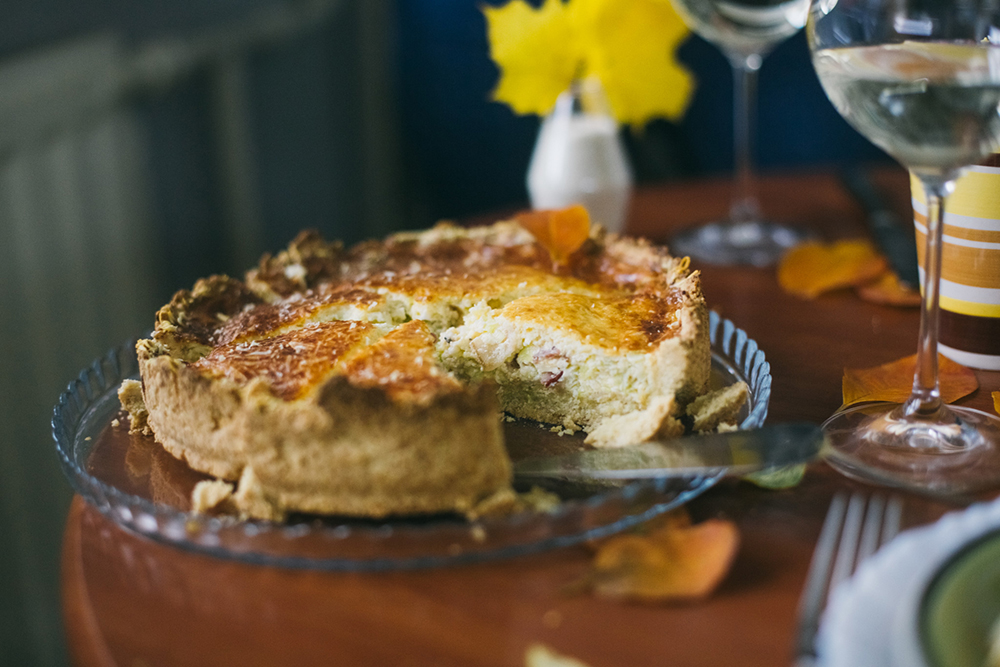
Favorite onion dish. Delicious, quick and festive. A large number of recipes for this pie exist. You can add ingredients to the recipe or simplify it to your taste.
5. Green onion salad with sour cream
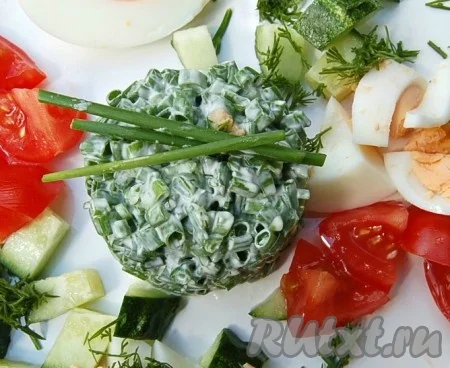
Easy, fast and healthy vitamin salad. It is juicy, tender and has a slight sweet taste. Excellent with meat dishes.
6. Salad with cabbage, three kinds of onions and walnuts

Dish with combination of three kinds of onions. Walnuts complete the taste range. The salad is nutritious and dietary at the same time. Dressing of shallots with mustard adds spice to this dish.

Salad with sweet and sour sauce. You can complement such a dish with croutons with soft cheese. Goes very well with meat dishes.
8. Colorful pickled onions for a kebab

For the festive table this dish is perfect. Unusual serving of onions – brightens up the color palette on your table. And a meat dish with such onions will be even tastier.
9. Vitamin salad with pickled onions, greens and black currants

Extraordinarily simple appetizer. From simple ingredients you get a bright and full of flavor dish. It will go perfectly with a kebab or any meat. Black currants are the main zest.
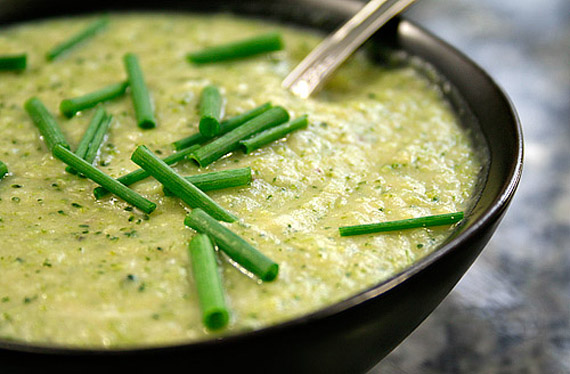
The flavor of leeks dominates this soup. It gives a delicate and rich flavor. The soup turns out thick and nutritious. You can add a little lemon juice to brighten the flavors.
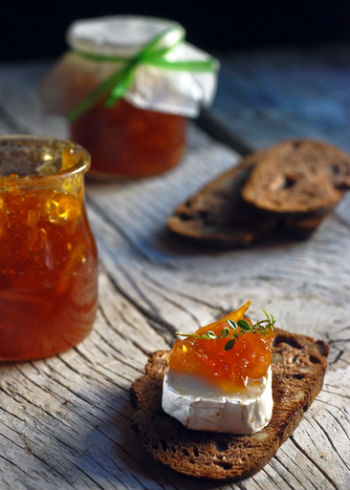
Sweet tooth will definitely be able to surprise this dish. It is delicious, very sweet, easy to prepare, looks appetizing. You can make sandwiches by adding butter on crusty bread.
12. Onion and chili pepper jam

An unusual jam. If you like to experiment with foods and culinary flavors, this exotic dish will surprise you. The taste mixes the sweetness of a fragrant bouquet of spices and the most pleasant aftertaste of tart, non-burning peppers.


